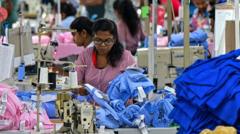The garment industry in countries like Cambodia and Sri Lanka stands at a critical juncture due to impending tariffs set to affect their largest export markets— the United States. As the deadline for trade negotiations approached, garment workers expressed an overwhelming sense of dread over the potential loss of their jobs and the ability to feed their families.
With a trade deal deadline of August 1st, President Trump announced new tariffs of 36% on Cambodian exports and 30% on Sri Lankan goods. This follows a period meant for negotiations that provided little reassurance to rippling concerns among workers. Nao Soklin, a Cambodian garment worker, highlighted the tangible fear gripping the community, urging President Trump to reconsider the tariff, stating, “We need our jobs to support our families.”
The figures illustrate the stakes: Cambodia exported more than $3 billion worth of apparel to the US last year, employing over 900,000 workers, while Sri Lanka's apparel sector contributed $1.9 billion and employed 350,000. With competing nations like Vietnam benefitting from lower tariffs, the pressure mounts for last-minute negotiations.
Authorities in both countries are hopeful for reduced tariffs, yet remain cautious. Cambodia and Sri Lanka's negotiating teams are advocating for further discussions; however, they also acknowledge the diminishing options within the global market, citing the precarious balance of maintaining economic relationships with both the US and China, a significant supplier of raw materials.
Moreover, the burdens of these tariffs disproportionately affect women, who make up roughly 70% of the garment workforce. For many, the prospect of layoffs looms heavily, potentially leading to increased poverty levels and significant family crises. Surangi Sandya, a female factory supervisor in Sri Lanka, articulated the anxiety threaded throughout the community— "If orders decrease... there may be a possibility that the company will shut down."
The precarious situation is compounded by wider economic challenges and weak labor protections in both countries. Leading experts argue the US tariffs ignore the mutual benefits of existing trade agreements, raising questions on the sustainability of such policies in the drastically affected regions.
As these garment workers pray for a resolution, the impact of US trade policy continues to resonate, threatening both their livelihoods and the stability of their communities.
With a trade deal deadline of August 1st, President Trump announced new tariffs of 36% on Cambodian exports and 30% on Sri Lankan goods. This follows a period meant for negotiations that provided little reassurance to rippling concerns among workers. Nao Soklin, a Cambodian garment worker, highlighted the tangible fear gripping the community, urging President Trump to reconsider the tariff, stating, “We need our jobs to support our families.”
The figures illustrate the stakes: Cambodia exported more than $3 billion worth of apparel to the US last year, employing over 900,000 workers, while Sri Lanka's apparel sector contributed $1.9 billion and employed 350,000. With competing nations like Vietnam benefitting from lower tariffs, the pressure mounts for last-minute negotiations.
Authorities in both countries are hopeful for reduced tariffs, yet remain cautious. Cambodia and Sri Lanka's negotiating teams are advocating for further discussions; however, they also acknowledge the diminishing options within the global market, citing the precarious balance of maintaining economic relationships with both the US and China, a significant supplier of raw materials.
Moreover, the burdens of these tariffs disproportionately affect women, who make up roughly 70% of the garment workforce. For many, the prospect of layoffs looms heavily, potentially leading to increased poverty levels and significant family crises. Surangi Sandya, a female factory supervisor in Sri Lanka, articulated the anxiety threaded throughout the community— "If orders decrease... there may be a possibility that the company will shut down."
The precarious situation is compounded by wider economic challenges and weak labor protections in both countries. Leading experts argue the US tariffs ignore the mutual benefits of existing trade agreements, raising questions on the sustainability of such policies in the drastically affected regions.
As these garment workers pray for a resolution, the impact of US trade policy continues to resonate, threatening both their livelihoods and the stability of their communities.

















